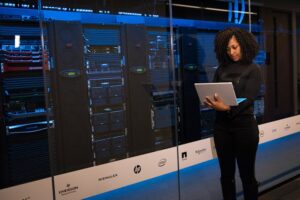There’s never been more pressure to optimize the workplace. Over the last few years, turbulent economic conditions have left many businesses looking for ways to cut costs and promote productivity in the office. Capitalizing on the Internet of Things (IoT) is a great way to do that.
IoT devices like smart thermostats and occupancy sensors have made big waves in the building sector. As these solutions become increasingly available, you can use them to make your workspace more productive and resource-efficient. Here’s how.
Tracking Movement
“Foot traffic maps may show that people spend too much time walking to a manager’s office, suggesting a layout change may shorten travel time.”
One common way to optimize workplaces with the IoT is to monitor foot traffic. Retailers were early adopters of this practice, accounting for over half of the Bluetooth beacon market because of their customer-tracking solutions. While stores may use this technology to see which areas get the most consumer attention, you can use it to gauge employee behaviors.
Occupancy sensors reveal how much time employees spend at their desks. Motion sensors show where people go the most when they get up or where they must walk to collaborate with co-workers. Bringing this data together lets you get a better grasp on workplace efficiency.
Foot traffic maps may show that people spend too much time walking to a manager’s office, suggesting a layout change may shorten travel time. Alternatively, low desk occupancy could mean a hybrid working environment may be better for your employees.
Reducing Energy Consumption
“Smart thermostats alone reduce heating and cooling bills by 8% on average.”
IoT data analytics also lets you minimize your office’s energy consumption. Smart thermostats alone reduce heating and cooling bills by 8% on average. That may not seem like much, but it can add to a significant total across an entire building.
Smart gadgets enable this efficiency because they automatically adjust to real-time data. That means not turning the AC on if rooms are already at ideal temperatures or shutting lights off if occupancy sensors don’t detect anyone. As a result, they use as little energy as possible while maintaining optimal conditions.
On top of improving your bottom line, these savings make your business more sustainable. You can market that eco-friendliness to enhance customer trust or meet growing environmental regulations.
Improving Employee Comfort
Because smart building solutions better maintain optimal conditions. Air quality sensors can adjust HVAC systems to remove contaminants from the air or alert you to change filters. Smart heating and cooling units can adapt as occupancy changes to ensure consistent temperatures.
This comfort has business implications. An uncomfortable working environment will make it hard for employees to remain engaged. Low engagement leads to poor performance and burnout, even to the point of turnover and absenteeism. Consequently, you can boost your workforce’s performance by making things more comfortable.
Your equipment also benefits from better environmental conditions. Experts recommend keeping server rooms between 50% and 70% relative humidity and roughly 64 to 80 degrees Fahrenheit. Smart HVAC solutions will maintain these levels to help your computers work as efficiently as possible.
Streamlining Hybrid Work
In many cases today, optimizing the workplace means deciding the right balance between in-office and remote work. The IoT can help in this area by making it easier for remote workers to connect to their in-person colleagues and equipment.
Remote setups are excellent for productivity, especially for employees facing long commutes or with kids. However, not being present with co-workers and being unable to access office hardware can stand in their way. You can overcome that barrier by using smart alternatives to conventional equipment, enabling remote access to printers, copiers and other tools.
New network technologies make hybrid setups more viable than ever. 5G ultracapacity offers near real-time communication between devices, ensuring remote workers experience no lag when connecting to the office. Higher bandwidths also enable larger IoT networks.
Optimizing Maintenance
“Maintenance alerts reduce downtime by 35% to 50% and extend your hardware’s life span by up to 40%.”
You can also use the IoT to better care for workplace equipment. Smart smoke alarms can alert you when it’s time to change batteries or other components. IoT-connected printers can automatically order new ink cartridges to prevent downtime. Predictive maintenance (PdM) takes these benefits even further.
PdM uses real-time IoT data to detect early warning signs of equipment failure. They then alert you as soon as the issue arises, letting you fix it before it causes larger problems.
These maintenance alerts reduce downtime by 35% to 50% and extend your hardware’s life span by up to 40%. Those savings more than makeup for the upfront costs of the necessary IoT devices.
The IoT Is the Key to an Optimized Workspace
The IoT has skyrocketed in manufacturing and consumer segments, but any business can benefit from it. As these five strategies show, implementing this technology can foster a more productive, cost-effective workplace. It all starts with knowing how it can help you.










